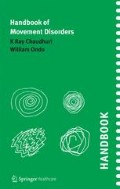Abstract
Drug-induced movement disorders remain a common and under-recognized problem. Blockade of the dopaminergic system results in multiple syndromes and will be the main focus of this discussion. These syndromes are often referred to as extrapyramidal side effects (EPSE) and include tardive dyskinesia, acute dystonic reactions, akathisia, drug-induced parkinsonism and neuroleptic malignant syndrome (Figure 6.1). Serotonin syndrome and drug-induced tremor are also briefly discussed.
Access this chapter
Tax calculation will be finalised at checkout
Purchases are for personal use only
Preview
Unable to display preview. Download preview PDF.
References
Correll CU, Schenk EM. Tardive dyskinesia and new antipsychotics. Curr Opin Psychiatry 2008; 21:151–156.
Ondo WG, Hanna PA, Jankovic J. Tetrabenazine treatment for tardive dyskinesia: assessment by randomized videotape protocol. Am J Psychiatry 1999; 156:1279–1281.
Richardson M, Bevans M, Read L, et al. Efficacy of the branched-chain amino acids in the treatment of tardive dyskinesia in men. Am J Psychiatry 2003; 160:1117–1124.
Lerner V, Miodownik C, Kaptsan A, et al. Vitamin B6 treatment for tardive dyskinesia: a randomized, double-blind, placebo-controlled, crossover study. J Clin Psychiatry 2007; 68: 1648–54
Lorberboym M, Treves TA, Melamed E, et al. [123I]-FP/CIT SPECT imaging for distinguishing drug-induced parkinsonism from Parkinson’s disease. Mov Disord 2006; 21:510–514.
Carroll BT, Lee JW, Graham KT, et al. Diagnosing subtypes of neuroleptic malignant syndrome: an introduction to the Lee-Carroll Scale. Ann Clin Psychiatry 2008; 20:47–48.
Boyer E, Shannon M. The serotonin syndrome. N Eng J Med 2005; 352:112–120.
Jankovic J. Tourette’s syndrome. N Engl J Med 2001; 345:1184–1192.
Nakamura K, Aminoff MJ. Huntington’s disease: clinical characteristics, pathogenesis and therapies. Drugs Today 2007; 43:97–116.
Sitburana O, Ondo WG. Tetrabenazine for hyperglycemic-induced hemichorea— hemiballismus. Mov Disord 2006; 21:2023–2025.
Rights and permissions
Copyright information
© 2009 Current Medicine Group, a part of Springer Science+Business Media
About this chapter
Cite this chapter
Ondo, W.G. (2009). Other movement disorders. In: Handbook of Movement Disorders. Springer Healthcare, Tarporley. https://doi.org/10.1007/978-1-908517-04-3_6
Download citation
DOI: https://doi.org/10.1007/978-1-908517-04-3_6
Publisher Name: Springer Healthcare, Tarporley
Print ISBN: 978-1-85873-440-8
Online ISBN: 978-1-908517-04-3
eBook Packages: MedicineMedicine (R0)

